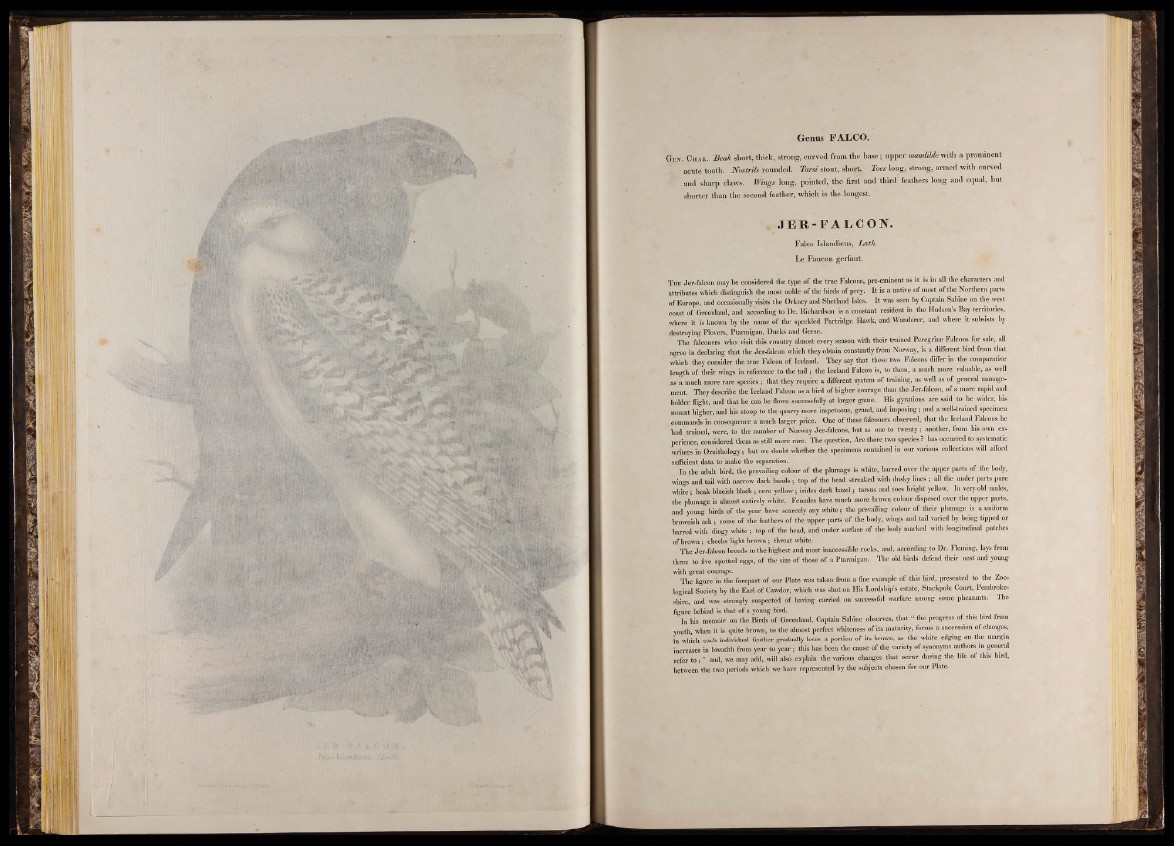
■ 1
.¡nfcS!
. J|P
■ 0 6 * 3 isifl ilMIHS
«^&k ■' v H i '■■'' # P $ V ,i tir^W’~‘mi^m^*Viiiili t i l
' M i l ; : ; ' ■
" ■ M
Hu |kw3E|
w m m m—
$SW*1
flP ilH lS P y W i i V,
Genus FALCO.
Gen. Char. Beak short, thick, strong, curved from the base; upper mandible with a prominent
acute tooth. Nostrils rounded. Tarsi stout, short. Toes long, strong, armed with curved
and sharp claws. Wings long, pointed, the first and third feathers long and equal, but
shorter than the second feather, which is the longest.
, JER-FALCON.
Falco Islandicus, Lath.
Le Faucon gerfaut.
T he Jer-falcon may be considered the type of the true Falcons, pre-eminent as it is in all the characters and
attributes which distinguish the most noble of the birds of prey. It is a native of most of tbe Northern parts
of Europe, and occasionally visits the Orkney and Shetland Isles. It was seen by Captain Sabine on the west
coast of Greenland, and according to Dr. Richardson is a constant resident in the Hudson’s Bay territories,
where it is known by the name of the speckled Partridge Hawk, and Wanderer, and where it subsists by
destroying Plovers, Ptarmigan, Ducks and Geese.
The falconers who visit this country almost every season with their trained Peregrine Falcons for sale, all
agree in declaring that the Jer-falcon which they obtain constantly from Norway, is a different bird from that
which they consider the true Falcon of Iceland. They say that these two Falcons differ in the comparative
length of their wings in reference to the tail; the Iceland Falcon is, to them, a much more valuable, as well
as a much more rare species ; that they require a different system of training, as well as of general management.
They describe the Iceland Falcon as a bird of higher courage than the Jer-falcon, of a more rapid and
bolder flight, and that he can be flown successfully at larger game. His gyrations are said to be wider, his
mount higher, and his stoop to the quarry more impetuous, grand, and imposing; and a well-trained specimen
commands in consequence a much larger price. One of these falconers observed, that the Iceland Falcons he
had trained, were, to the number of Norway Jer-falcons, but as one to twenty; another, from his own experience,
considered them as still more rare. The question, Are there two species ? has occurred to systematic
writers in Ornithology; but we doubt whether the specimens contained in our various collections will afford
sufficient data to make the separation.
In the adult bird, the prevailing colour of the plumage is white, barred over the upper parts of the body,
wings and tail with narrow dark bands; top of the head streaked with dusky lines ; all the under parts pure
white; beak blueish black; cere yellow; irides dark hazel; tarsus and toes bright yellow. In very old males,
the plumage is almost entirely white. Females have much more brown colour disposed over the upper parts,
and young birds of the year have scarcely any white; the prevailing colour of their plumage is a uniform
brownish ash ; some of the feathers of the upper parts of the body, wings and tail varied by being tipped or
barred with dingy white ; top of the head, and under surface of the body marked with longitudinal patches
of brown; cheeks light brown; throat white.
The Jer-falcon breeds in the highest aud most inaccessible rocks, and, according to Dr. Fleming, lays from
three to five spotted eggs, of the size of those of a Ptarmigan. The old birds defend their nest and young
with great courage.
The figure in the forepart of our Plate was taken from a fine example of this bird, presented to the Zoological
Society by the Earl of Cawdor, which was shot on His Lordship’s estate, Stackpole Court, Pembrokeshire,
and was strongly suspected of having carried on successful warfare among some pheasants. The
figure behind is that of a young bird.
In his memoir on the Birds of Greenland, Captain Sabine observes, that “ the progress of this bird from
youth, when it is quite brown, to the almost perfect whiteness of its maturity, forms a succession of changes,
in which each individual feather gradually loses a portion of its brown, as the white edging on the margin
increases in breadth from year to year; this has been the cause of the variety of synonyms authors in general
refer to ; ” and, we may add, will also explain the various changes that occur during the life of this bird,
between the two periods which we have represented by the subjects chosen for our Plate.